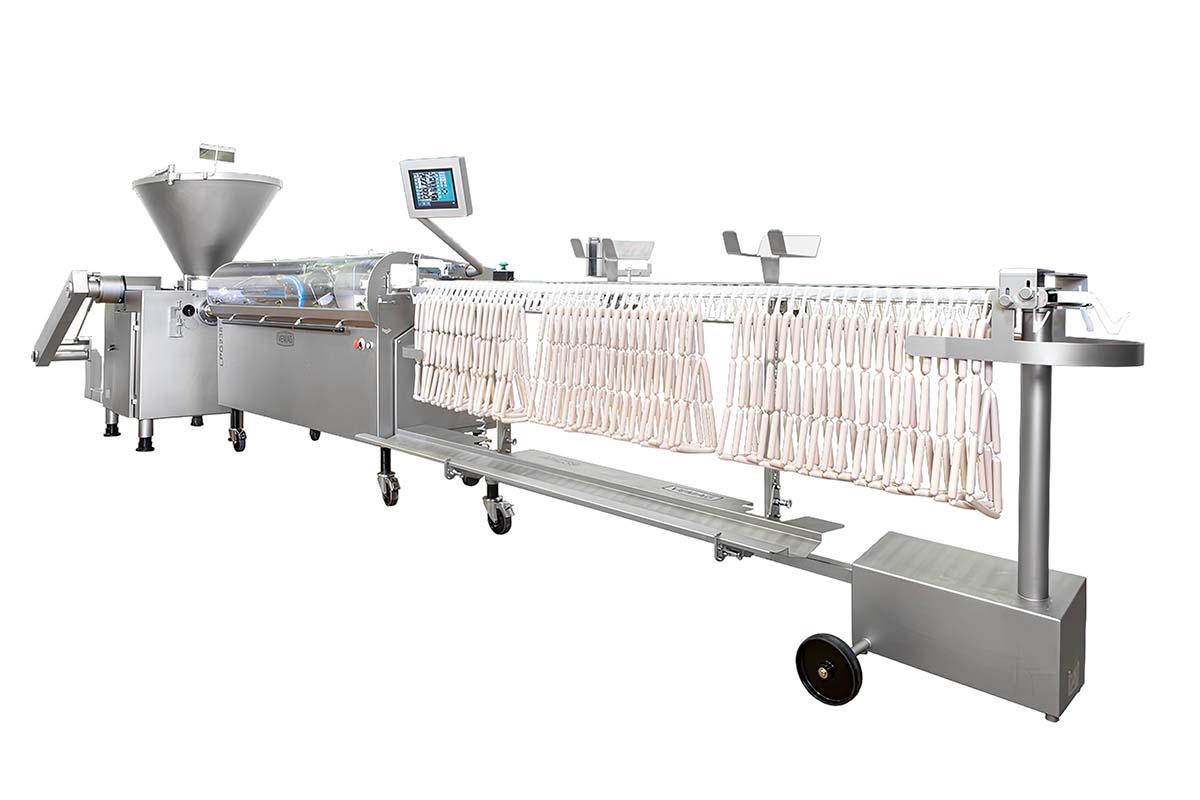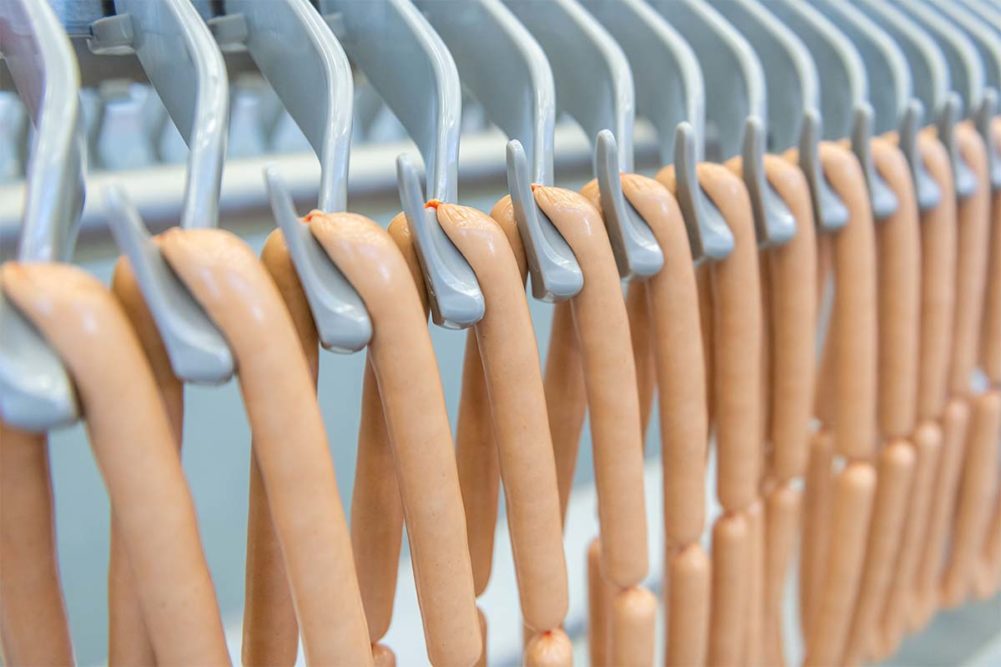Since the pandemic, sausage products have been on the rise and continue to be in demand, with the latest Circana data showing that the category is up more than 15% in the past few years.
The market is looking for quality meat products at lower price points, and sausage is ideally placed with growth in breakfast sausages, hotdogs, fully cooked links, and dinner sausages.
Automation that supports the more flexible use of labor seems to be among the highest priorities today. Once in the domain of large commercial and industrial processors, recent advancements in technology translate into meaningful levels of automation that are becoming affordable for even the smallest operations.
Product changes are also becoming more important for commercial and artisan sausage processors.
That means companies are focused on ensuring they have the latest and greatest stuffing, linking and hanging systems to meet the demand.
Marel’s role in the sausage industry is to provide innovative, full-line solutions and individual equipment for its customers’ product needs.
“Our customers are looking for more automated processes to combat labor shortages and product quality control improvement,” said Robert Michael Scott, regional marketing manager in Georgia for the Iceland-based company, with US offices in Lenexa, Kan. “Better weight and length control lead to better yields. As yields increase, profits do as well.”
Handtmann Inc., is a solution supplier to artisan, commercial and industrial sausage makers with a full line of advanced grinding, mixing, and emulsifying technologies solutions, plus filling, portioning, inline grinding, and automated full line linking/hanging solutions.
“Smarter product preparation with intelligent Inotec grinding, mixing and emulsifying technologies creates consistent product very efficiently in shortened batch times that can even increase batches/shift,” said Max King, vice president of sales for the Lake Forest, Ill.-based company. “Design innovations and manufacturing advancements now mean that the various available grinding, mixing and emulsifying models can also be tailored to specific operational needs.”
An evolution
As late as 1960, packers were producing no more than 500 hot dogs an hour and they were not uniform in weight or size. Ray Townsend of Townsend Engineering set out to find a better way, and his “Frank-a-Matic,” a machine that virtually eliminated waste and made hot dogs at a rate of 36,000 an hour, became a game-changer. Three years after its introduction, the Townsend Frank-a-Matic DB series made more than 90% of all skinless sausages in the world.
In 1986, Townsend Engineering released the RT6, and 10 years later, the NL SmartLinker and the NL FLEXLinker in 1999. In 2005, Stork Food Systems purchased Townsend Engineering, which was then purchased by Marel two years later.
“In 2019, the LK400 Frank-A-Matic Linker was introduced to the market,” Scott said. “Although the strengths of the machine have not changed, we improved weight control, length control and machine reliability.”
 Vemag linking systems from Reiser are playing an essential role in a growing number of sausage processing companies. (Source: Reiser)
Vemag linking systems from Reiser are playing an essential role in a growing number of sausage processing companies. (Source: Reiser)New and Improved
Over the years, Vemag linking systems from Reiser, Canton, Mass., have become a big player in sausage kitchens, from handcrafted sausage to completely automated systems.
Björn Fechner, head of product management and specialist for linking systems at Vemag, noted over the past years, the focus has been on making Vemag equipment more efficient and user-friendly, developing machines that increase productivity and automation.
“Difficult times with high production costs for our customers pushed us to develop linking systems which are easy to operate with maximum flexibility for all the production needs and highly economical in the use of resources,” he said. “Cost of ownership was always a big topic for our customers and a big challenge for us. With our new linking systems, we have managed to build machines that reduce cost of ownership with no compromises in handling, efficiency, and output.”
The company’s Vemag LPG 218 Hot Dog system with hanging unit Vemag AH219 was developed to increase efficiency and reduce production costs, as was the identical LPG 238 for a mirrored production process offering artificial and collagen casing applications.
“They offer perfect linking that fulfils all customer requirements — perfect weights, accurate product length, and reproducible accuracy,” Fechner said. “Both solutions can be operated in parallel as mirrored factory solutions. This is a great advantage in industrial production, as it saves on personnel and makes optimum use of production space. The integrated scale system reduces give away and increases productivity.”
For the fresh sausage area, Vemag and Reiser offer the Vemag LL335 link loading system combined with its SL319 tray handling conveyor, which automatically conveys, collates, and deposits sausages into tray packaging, ready for the packaging machine.
The newest Vemag Maschinenbau GmbH solutions will be shown in March 2024 at Anuga FoodTec 2024, in Cologne, Germany.
The newest Handtmann technologies make changeovers much simpler and foolproof, such as the Handtmann All-In-One solution that allows processors to efficiently produce sausage sticks, patties and any number of other 3-D shapes on a single piece of equipment while requiring a smaller footprint than ever.
“These tailored specifications and precision control lets Inotec preparation technologies operate with very customized product-specific processing parameters and their line communication features support the highest level of automated plant efficiency,” King said.
Another example of a meaningful technical improvement is the radial design of cutting set in Inotec emulsifiers.
“They provide continual automated knife adjustment during operation that now lets processors maintain product consistency without human intervention while reducing unwanted friction and extending the cutting set life to reduce sharpening and replacement costs,” King said.
He noted Handtmann sausage solutions are powered by Handtmann servo-controlled vacuum fillers that deliver consistent, gram-sensitive precision for safe operation within the industry’s tightest weight parameters.
“Their advanced auger system, optimized feed system geometry and almost 100 other unmatched safety, hygiene and performance innovations, including automated casing loading, horn stabilization, accurate voiding and integrated check weighing with automatic weight adjustment make Handtmann a trusted platform for sausage production,” he said.
Marel has recently added an option to its linkers for an integrated scale for weight calibrations.
“The integrated scale allows the operator to place the links on the weighing platform and the software will change the weight calibration automatically taking the guesswork out of weight control,” Scott said. “The Marel linkers use Kevlar linking belts that do not stretch for accurate length control and servo motors that have improved weight control. The Marel linkers also have no flat surfaces to create a more hygienic contact surface.”
Maintenance Matters
Marel has made improvements to its linkers to maximize uptime by making maintenance procedures easier.
“All access panels on the linker have double seals to prevent water intrusion,” Scott said. “Electrical panels have also been individually sealed to prevent intrusion. The high-voltage and low-voltage electrical panels have their cabinets. Scheduled preventative maintenance is well-defined within the user manuals.”
Serviceability of the systems is of great importance to Vemag when starting a new design.
“Our preventative maintenance (PM) team is always on the road to offer service,” Fechner said. “Every 2,000 running hours, we offer our customers PM to keep the machines up to date, before something happens. This ensures maximum availability of the equipment and reduced downtime or production loss.”



